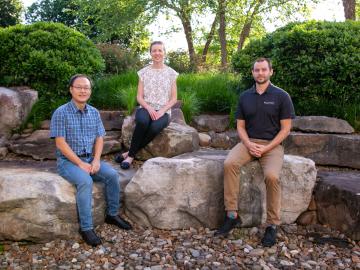
Filter News
Area of Research
- (-) National Security (25)
- (-) Supercomputing (39)
- Advanced Manufacturing (2)
- Biology and Environment (52)
- Biology and Soft Matter (1)
- Building Technologies (2)
- Clean Energy (49)
- Computational Biology (1)
- Computer Science (1)
- Electricity and Smart Grid (1)
- Functional Materials for Energy (2)
- Fusion and Fission (15)
- Isotopes (3)
- Materials (43)
- Materials for Computing (6)
- Neutron Science (14)
- Renewable Energy (1)
News Topics
- 3-D Printing/Advanced Manufacturing (1)
- Artificial Intelligence (9)
- Big Data (4)
- Bioenergy (3)
- Biology (7)
- Biomedical (4)
- Biotechnology (1)
- Buildings (3)
- Chemical Sciences (2)
- Climate Change (7)
- Computer Science (14)
- Coronavirus (4)
- Critical Materials (1)
- Cybersecurity (5)
- Decarbonization (2)
- Energy Storage (3)
- Environment (4)
- Exascale Computing (6)
- Frontier (7)
- Grid (5)
- High-Performance Computing (9)
- Machine Learning (8)
- Materials (8)
- Materials Science (5)
- Microscopy (2)
- Nanotechnology (3)
- National Security (13)
- Neutron Science (2)
- Partnerships (1)
- Physics (2)
- Quantum Computing (7)
- Quantum Science (4)
- Security (4)
- Simulation (5)
- Space Exploration (1)
- Summit (7)
- Sustainable Energy (2)
Media Contacts

The U.S. Department of Energy’s Oak Ridge National Laboratory celebrated the debut of Frontier, the world’s fastest supercomputer and the dawn of the exascale computing era.

Travis Humble has been named director of the Quantum Science Center headquartered at ORNL. The QSC is a multi-institutional partnership that spans industry, academia and government institutions and is tasked with uncovering the full potential of quantum materials, sensors and algorithms.

Cameras see the world differently than humans. Resolution, equipment, lighting, distance and atmospheric conditions can impact how a person interprets objects on a photo.

When the COVID-19 pandemic stunned the world in 2020, researchers at ORNL wondered how they could extend their support and help

Though Nell Barber wasn’t sure what her future held after graduating with a bachelor’s degree in psychology, she now uses her interest in human behavior to design systems that leverage machine learning algorithms to identify faces in a crowd.

In front of family and friends, Lt. Col. Jessica Critcher and Maj. Micah McCracken gave their final report on their eye-opening year as ORNL military fellows.

Doug Kothe has been named associate laboratory director for the Computing and Computational Sciences Directorate at ORNL, effective June 6.

The Department of Energy’s Office of Science has selected three Oak Ridge National Laboratory scientists for Early Career Research Program awards.

To optimize biomaterials for reliable, cost-effective paper production, building construction, and biofuel development, researchers often study the structure of plant cells using techniques such as freezing plant samples or placing them in a vacuum.

Scientists develop environmental justice lens to identify neighborhoods vulnerable to climate change
A new capability to identify urban neighborhoods, down to the block and building level, that are most vulnerable to climate change could help ensure that mitigation and resilience programs reach the people who need them the most.


